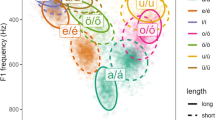Abstract
Reading a word may involve the spoken language in two ways: in the conversion of letters to phonemes according to the conventions of the language’s writing system and the assimilation of phonemes according to the language’s constraints on speaking. If so, then words that require assimilation when uttered would require a change in the phonemes produced by grapheme-phoneme conversion when read. In two experiments, each involving 40 fluent readers, we compared visual lexical decision on Korean orthographic forms that would require such a change (C stimuli) or not (NC stimuli). We found that NC words were accepted faster than C words, and C nonwords were rejected faster than NC nonwords. The results suggest that phoneme-to-phoneme transformations involved in uttering a word may also be involved in visually identifying the word.
Similar content being viewed by others
References
Abramson M., Goldinger S. (1997) What the reader’s eye tells the mind’s ear: silent reading activates inner speech. Perception & Psychophysics 59: 1059–1068
Berent I., Shimron J., Vaknin V. (2001) Phonological constraints on reading: Evidence from the obligatory contour principle. Journal of Memory and Language 44: 644–665
Chomsky, N., & Halle, M. (1968). The sound pattern of English. New York: Harper & Row.
Frost R. (1998) Toward a strong phonological theory of visual word recognition: True issues and false trails. Psychological Bulletin 123: 71–99
KAIST (1999). Kaist concordance program [On-line]. Available: http://csfive.kaist.ac.kr/kcp/.
Kirk, R. E. (1995). Experimental design: Procedures for the behavioral sciences (3rd ed.). Pacific Grove, CA: Brooks/Cole.
Lee Y., Moreno M., Park H.-Y., Carello C., Turvey M. T. (2006) Phonological assimilation and visual word recognition. Journal of Psycholinguistic Research 35: 513–530
Lukatela G., Eaton T., Sabadini L., Turvey M. T. (2004) Vowel duration affects visual word identification: Evidence that the mediating phonology is phonetically informed. Journal of Experimental Psychology: Human Perception and Performance 30: 151–162
Lukatela G., Eaton T., Lee C., Carello C., Turvey M. T. (2002) Equal homophonic priming with words and pseudowords. Journal of Experimental Psychology: Human Perception and Performance 28: 3–21
Lukatela G., Frost S., Turvey M. T. (1999) Identity priming in English is compromised by phonological ambiguity. Journal of Experimental Psychology: Human Perception and Performance 25: 775–790
Seo, S. (1998). Frequency Tables above 7 frequencies of Modern Korean Words for Yensei-word cluster 1–9. Yeonsei Univ. Language Information Research Center (Internal Report).
Sorim M. (2006) Essence Korean-English dictionary: Deluxe (4th ed.). Minjung Sorim Publishers, Seoul
Sung K. (1995) New ace: Korean language dictionary. Kum Sung Textbook Co, Seoul
Author information
Authors and Affiliations
Corresponding author
Rights and permissions
About this article
Cite this article
Lee, Y., Moreno, M.A., Carello, C. et al. Do Phonological Constraints on the Spoken Word Affect Visual Lexical Decision?. J Psycholinguist Res 42, 191–204 (2013). https://doi.org/10.1007/s10936-012-9211-9
Published:
Issue Date:
DOI: https://doi.org/10.1007/s10936-012-9211-9




